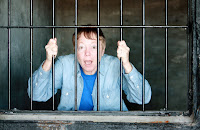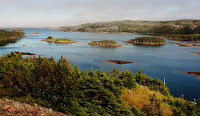
We arrived at Clarke’s Beach on the 25th and then drove less than 10 miles to the Canadian Legion Hall. We were fed a sumptuous meal cooked by Ken, a huge man who is a true Newfie. The Mayor gr eeted us with an uplifting short speech. It was a perfect evening with a wondrous sunset, and we hung around the
eeted us with an uplifting short speech. It was a perfect evening with a wondrous sunset, and we hung around the  marina for awhile, soaking in the wonderful weather. Adding to our joy, across the water, was an old Airstream parked near a bright red cottage. It matched the roof of a big, picturesque, local church. Newfies love rich colors; they are not a boring people.
marina for awhile, soaking in the wonderful weather. Adding to our joy, across the water, was an old Airstream parked near a bright red cottage. It matched the roof of a big, picturesque, local church. Newfies love rich colors; they are not a boring people.
The next day, half of our group--16 couples--drove several miles to Garden Cove to catch a 42-foot cabin cruis er bound for the remote, scenic Woody Island Resort. Our leaders had arranged for two days in a lodge on the Island. The lodge could accommodate only half of us at one time. We were in Group 2, leaving two days later for the island. While the first group was gone, we made the best of a great touring opportunity. We drove about 20 miles to Harbour Grace, home of the old Ae
er bound for the remote, scenic Woody Island Resort. Our leaders had arranged for two days in a lodge on the Island. The lodge could accommodate only half of us at one time. We were in Group 2, leaving two days later for the island. While the first group was gone, we made the best of a great touring opportunity. We drove about 20 miles to Harbour Grace, home of the old Ae rodrome Landing Field, built in 1927. It’s now a National Historic Site, which is now only a shadow (grassy strip) of its former self. It had world-class prominence in the 1930s, as it was used by Amelia Earhart in her successful trans-Atlantic solo flight. She was the first woman to accomplish that feat on May 20, 1932. Just think of how far we have come in only 79 years. The strip is still used by light aircraft; a plaque and sign are there to honor Amelia, along with 40 other pioneer pilots, who flew from that field during the years 1927-1937. Eddie Rickenbacker was one of them. We there alone on silent, hallowed ground. There were only some ponies grazing peacefully nearby.
rodrome Landing Field, built in 1927. It’s now a National Historic Site, which is now only a shadow (grassy strip) of its former self. It had world-class prominence in the 1930s, as it was used by Amelia Earhart in her successful trans-Atlantic solo flight. She was the first woman to accomplish that feat on May 20, 1932. Just think of how far we have come in only 79 years. The strip is still used by light aircraft; a plaque and sign are there to honor Amelia, along with 40 other pioneer pilots, who flew from that field during the years 1927-1937. Eddie Rickenbacker was one of them. We there alone on silent, hallowed ground. There were only some ponies grazing peacefully nearby.
A few miles from the airstrip on the edge of the harbor stands a lovely statue honoring Earhart. As well, the grand old ship, S.S.  Kyle (see top photo), one of the last of the coal burners, came to rest there in 1968 where she is still grounded after all these years. The Kyle was built in England around the time of the Titanic and served primarily as a Newfoundland-Labrador coastal ferry boat for many years. In her prime she was an avant-garde, glorious, speedy vessel, strengthened to cope with icy waters. In 1913 she was described as a “specimen of marine architecture” by the Evening Telegram as she entered the Narrows of St. John’s. We hope that she will one day be restored, but that would take megabucks.
Kyle (see top photo), one of the last of the coal burners, came to rest there in 1968 where she is still grounded after all these years. The Kyle was built in England around the time of the Titanic and served primarily as a Newfoundland-Labrador coastal ferry boat for many years. In her prime she was an avant-garde, glorious, speedy vessel, strengthened to cope with icy waters. In 1913 she was described as a “specimen of marine architecture” by the Evening Telegram as she entered the Narrows of St. John’s. We hope that she will one day be restored, but that would take megabucks.
When it was our turn to travel to Woody Island, it was a chilly, gray, foggy morning,  so we saw no wildlife. We did see some old stages (fishing huts). Gloria elected to stay in the comfortable lodge to rest and play joker even as the weather had improved. Jerry went with friends, Chuck, Joyce and Larry, on a long hike to the end of the island in bright, warm sunshine. We saw a few tidy. seasonal cottages, but there is no electricity on the island; generators are required for power. Apparently no one w
so we saw no wildlife. We did see some old stages (fishing huts). Gloria elected to stay in the comfortable lodge to rest and play joker even as the weather had improved. Jerry went with friends, Chuck, Joyce and Larry, on a long hike to the end of the island in bright, warm sunshine. We saw a few tidy. seasonal cottages, but there is no electricity on the island; generators are required for power. Apparently no one w inters there. High points of the hike were lovely wildflowers and an old cemetery, but the historic community buildings have not been maintained. The residents of the once-thriving island
inters there. High points of the hike were lovely wildflowers and an old cemetery, but the historic community buildings have not been maintained. The residents of the once-thriving island community of 400 began arriving in the early 1800s from Europe. They were mostly Protestant fisherman who also raised vegetables, sheep, cows, and goats. Most residents were relocated by the Canadian government back in 1968, as it was too costly to provide services to such a remote place. A few people elected to stay on their beloved island for years without government help.
community of 400 began arriving in the early 1800s from Europe. They were mostly Protestant fisherman who also raised vegetables, sheep, cows, and goats. Most residents were relocated by the Canadian government back in 1968, as it was too costly to provide services to such a remote place. A few people elected to stay on their beloved island for years without government help.
The entrepreneurial owner of the summer resort and boat that carried us there really knows how to please his guests. The rooms are not fancy, but they are clean and utilitarian. The lodge is comfortable and cozy with a fireplace. The friendly, informal kitchen staff members were fabulous. Anytime we wanted a cup of coffee or tea it was available. The meals with hot rolls were superb by Newfoundland standards; not much seasoning is used in this province.
owner of the summer resort and boat that carried us there really knows how to please his guests. The rooms are not fancy, but they are clean and utilitarian. The lodge is comfortable and cozy with a fireplace. The friendly, informal kitchen staff members were fabulous. Anytime we wanted a cup of coffee or tea it was available. The meals with hot rolls were superb by Newfoundland standards; not much seasoning is used in this province.
The best activity during the two days at the resort was the evening entertainment. The musician was a quality singer of Irish and Island ballads, and he also played several accordions—a highly popular Newfie instrument. Our group sang and danced until midnight; Gloria demonstrated a huge burst of energy. Our levity was increased significantly by four wild psychiatric nurses-- not a part of our group--but boat mates nevertheless. They were all over one of our bachelors like a cheap suit even though his lady friend was with him. John is a slow-talking, laid back, humorous, Georgian, who did not appear concerned about his old heart. Maybe he knew that his newly found fans were all trai ned in CPR. At one point the nurses slipped out and put on costumes. They soon returned to pull several men from our group to the dance floor, including our ultra-conservative, mild-mannered friend, Lloyd. He had earlier delighted the group with his renditi
ned in CPR. At one point the nurses slipped out and put on costumes. They soon returned to pull several men from our group to the dance floor, including our ultra-conservative, mild-mannered friend, Lloyd. He had earlier delighted the group with his renditi on of the “ugly stick” beat. We swear he had nothing strong to drink. But you never know what a wacky nurse can bring out in a sane man, who on hobbled knees, bounced to a dance beat he had never before experienced. Wife, Elaine, our Northern Virginia friend for 24 years, just smiled. However, some wondered why Lloyd was found sleeping on a couch in the lodge later that night. We are not sure how Elaine really felt, but it was necessary to confine her for a
on of the “ugly stick” beat. We swear he had nothing strong to drink. But you never know what a wacky nurse can bring out in a sane man, who on hobbled knees, bounced to a dance beat he had never before experienced. Wife, Elaine, our Northern Virginia friend for 24 years, just smiled. However, some wondered why Lloyd was found sleeping on a couch in the lodge later that night. We are not sure how Elaine really felt, but it was necessary to confine her for a couple days in order to protect Lloyd.
couple days in order to protect Lloyd.
On our way back to Garden Cove, the boat stopped mid-way at a primitive, plastic-covered shelter, where we enjoyed a fire, walk on the beach, and a picnic. The lively nurses continued to entertain. Back at camp, we took time during a rainstorm to get our laundry done and do some shopping. We were late getting back to camp for a game of joker, so our friends sent out a posse to find us; we stopped them at the edge of the campground.
Click on photos to enlarge them. Click back arrow to return to normal view.

























































